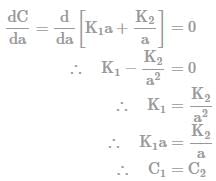SSC Exam > SSC Questions > The economic size of conductor is determined...
Start Learning for Free
The economic size of conductor is determined by-
- a)Current carrying capacity
- b)Transmission voltage
- c)Kelvin's law
- d)None of these
Correct answer is option 'C'. Can you explain this answer?
| FREE This question is part of | Download PDF Attempt this Test |
Verified Answer
The economic size of conductor is determined by-a)Current carrying ca...
Let, area of cross-section of conductor = a
View all questions of this test
annual interest and depreciation on capital cost of the conductor = C1
annual running charges = C2
Now, annual interest and depreciation cost is directly proportional to the area of conductor.
i.e., C1 = K1a
And, annual running charges are inversely proportional to the area of conductor.
C2 = K2/a
Where, K1 and K2 are constants.
Now, Total annual cost = C = C1 + C2
C = K1a + K2/a
For C to be minimum, the differentiation of C w.r.t a must be zero. i.e. dC/da = 0.
Therefore,

"Kelvin's law states that the most economical size of a conductor is that for which annual interest and depreciation on the capital cost of the conductor is equal to the annual cost of energy loss." From the above derivation, the economical cross-sectional area of a conductor can be calculated
as,
a = √(K2/K1)

|
Explore Courses for SSC exam
|

|
Similar SSC Doubts
The economic size of conductor is determined by-a)Current carrying capacityb)Transmission voltagec)Kelvin's lawd)None of theseCorrect answer is option 'C'. Can you explain this answer?
Question Description
The economic size of conductor is determined by-a)Current carrying capacityb)Transmission voltagec)Kelvin's lawd)None of theseCorrect answer is option 'C'. Can you explain this answer? for SSC 2024 is part of SSC preparation. The Question and answers have been prepared according to the SSC exam syllabus. Information about The economic size of conductor is determined by-a)Current carrying capacityb)Transmission voltagec)Kelvin's lawd)None of theseCorrect answer is option 'C'. Can you explain this answer? covers all topics & solutions for SSC 2024 Exam. Find important definitions, questions, meanings, examples, exercises and tests below for The economic size of conductor is determined by-a)Current carrying capacityb)Transmission voltagec)Kelvin's lawd)None of theseCorrect answer is option 'C'. Can you explain this answer?.
The economic size of conductor is determined by-a)Current carrying capacityb)Transmission voltagec)Kelvin's lawd)None of theseCorrect answer is option 'C'. Can you explain this answer? for SSC 2024 is part of SSC preparation. The Question and answers have been prepared according to the SSC exam syllabus. Information about The economic size of conductor is determined by-a)Current carrying capacityb)Transmission voltagec)Kelvin's lawd)None of theseCorrect answer is option 'C'. Can you explain this answer? covers all topics & solutions for SSC 2024 Exam. Find important definitions, questions, meanings, examples, exercises and tests below for The economic size of conductor is determined by-a)Current carrying capacityb)Transmission voltagec)Kelvin's lawd)None of theseCorrect answer is option 'C'. Can you explain this answer?.
Solutions for The economic size of conductor is determined by-a)Current carrying capacityb)Transmission voltagec)Kelvin's lawd)None of theseCorrect answer is option 'C'. Can you explain this answer? in English & in Hindi are available as part of our courses for SSC.
Download more important topics, notes, lectures and mock test series for SSC Exam by signing up for free.
Here you can find the meaning of The economic size of conductor is determined by-a)Current carrying capacityb)Transmission voltagec)Kelvin's lawd)None of theseCorrect answer is option 'C'. Can you explain this answer? defined & explained in the simplest way possible. Besides giving the explanation of
The economic size of conductor is determined by-a)Current carrying capacityb)Transmission voltagec)Kelvin's lawd)None of theseCorrect answer is option 'C'. Can you explain this answer?, a detailed solution for The economic size of conductor is determined by-a)Current carrying capacityb)Transmission voltagec)Kelvin's lawd)None of theseCorrect answer is option 'C'. Can you explain this answer? has been provided alongside types of The economic size of conductor is determined by-a)Current carrying capacityb)Transmission voltagec)Kelvin's lawd)None of theseCorrect answer is option 'C'. Can you explain this answer? theory, EduRev gives you an
ample number of questions to practice The economic size of conductor is determined by-a)Current carrying capacityb)Transmission voltagec)Kelvin's lawd)None of theseCorrect answer is option 'C'. Can you explain this answer? tests, examples and also practice SSC tests.

|
Explore Courses for SSC exam
|

|
Signup for Free!
Signup to see your scores go up within 7 days! Learn & Practice with 1000+ FREE Notes, Videos & Tests.


















